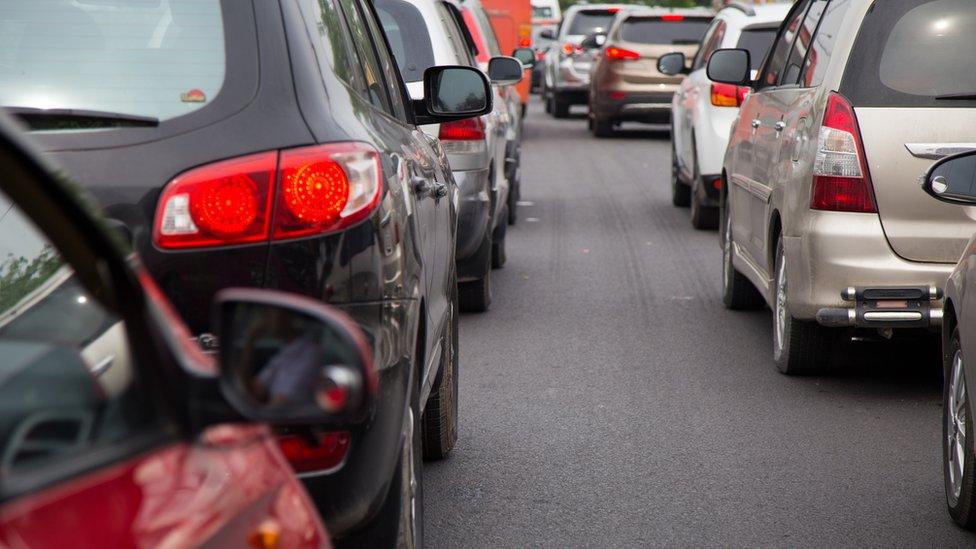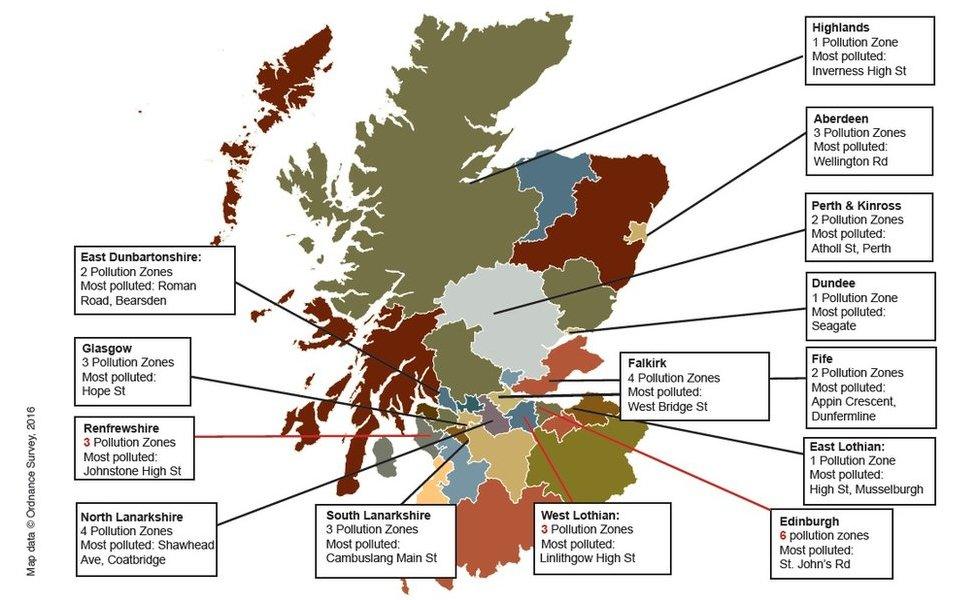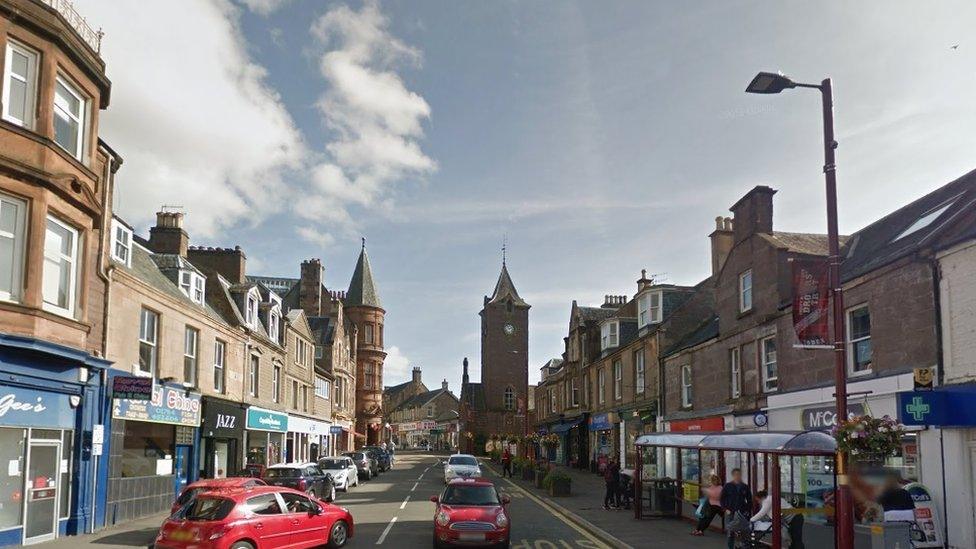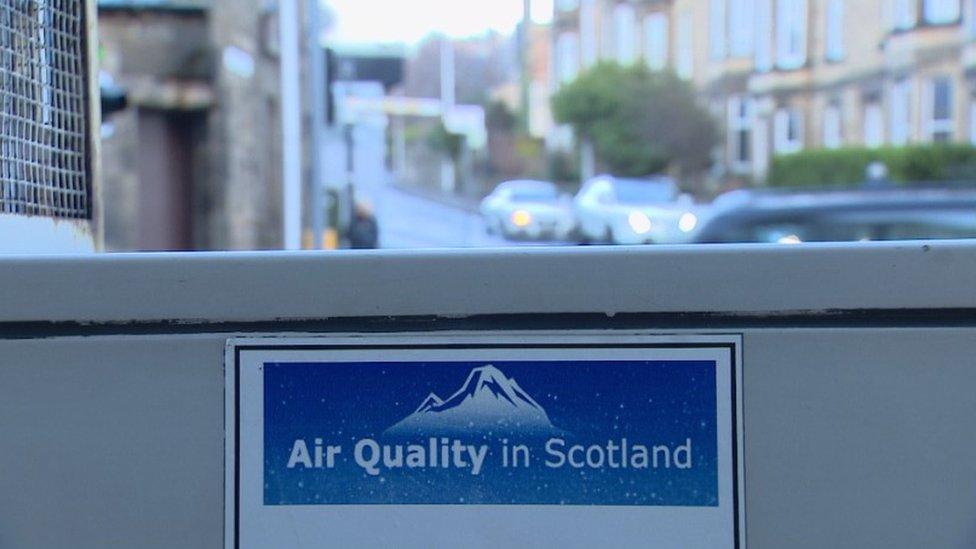Number of pollution zones in Scotland rises to 38
- Published

The number of pollution zones in Scotland has risen, according to new figures from Friends of the Earth (FoE) Scotland.
The group found that there are now 38 zones where safety standards for air quality are regularly broken - five more than last year.
The environmental campaigners warned the pollution levels were a "public health crisis".
The Scottish government said it was determined to improve air quality.
A spokeswoman said the government was working to ensure Scotland's first low emission zone was in place next year
The new data found that Scotland's most polluted street was Hope Street in Glasgow, with a number of busy roads in some of the country's largest cities also having high levels of pollution.
One of the most surprising entries on the list is Crieff High Street where levels for particulate matter are above the Scottish target.

Friends of the Earth Scotland's map shows the country's pollution zones
Edinburgh's Salamander Street is one of five new pollution zones - or air quality management areas - that were identified in 2016.
The others were in Johnstone and Renfrew in Renfrewshire, and in Linlithgow and Newton in West Lothian.
FoE Scotland claim air pollution causes more than 2,500 early deaths in Scotland each year, external and the issue should be treated with more urgency by government and councils.


Hope Street in Glasgow tops the list of the most polluted streets in Scotland
Nine most polluted street for nitrogen dioxide in 2016
Hope Street, Glasgow - 65
St John's Road, Edinburgh - 49
Wellington Road, Aberdeen - 46
Seagate, Dundee - 46
Main Street, Cambuslang - 45
Union Street Roadside, Aberdeen - 43
Queensferry Road, Edinburgh - 42
Dumbarton Road, Glasgow - 42
Atholl Street, Perth - 40
Figures in microgrammes per cubic metre. The European Ambient Air Quality directive limits nitrogen dioxide to 40 microgrammes per cubic metre.
(Source: Friends of the Earth Scotland)

FoE Scotland campaigner Emilia Hanna said it was particularly harmful for small children, pregnant women and people living in poverty.
"For people living in an official pollution zone or near traffic-choked streets, breathing in toxic air is an inescapable fact of life," she said.
"It should not be this way, we have the right to breathe clean air just as we have the right to drink clean water.
"The Scottish government and local authorities are not tackling this public health crisis with the seriousness and urgency required."
Polluting cars
She called on the government to provide "significant funding" to councils to support low emission zones and she urged them to introduce measures to cut traffic levels.
The government's "zeal for road building" was worsening the problem, she added.
"Other cities have shown that pollution can be tackled. In Seville, pollution levels were cut in half via the introduction of 80km (50 miles) of segregated cycle routes," she said.
"In London, the mayor has promised to introduce an ultra low emission zone a year ahead of schedule as well as taxing polluting cars via a T-charge. In Paris, the mayor has just announced plans to cut the number of polluting cars in half."


Creiff High Street failed the Scottish air quality objective
Seven most polluted streets for particulate matter
Atholl Street, Perth - 21
Queensferry Road, Edinburgh - 20
Salamander Street, Edinburgh - 20
King Street, Aberdeen - 19
High Street, Crieff - 19
West Bridge Street, Falkirk - 19
Glasgow Road, Edinburgh - 18
Figures in microgrammes per cubic metre. The Scottish air quality objective is 18 microgrammes per cubic metre.
(Source: Friends of the Earth Scotland)

Glasgow resident Jean Nelson, who suffers from chronic obstructive pulmonary disease (COPD) believes air pollution is affecting her health.
The 59-year-old said: "I live at a junction where the traffic is nose to tail almost every minute of the day, and I feel like I'm choking on fumes on a daily basis.
"Air pollution makes it hard for me to breathe and on bad days, I can barely walk.
"I do not own a car and often have to take the bus from Hope Street. I can see black smoke coming out of the buses and sometimes am forced to take a taxi just to escape the fumes.
"We need less traffic on our roads if air pollution is going to improve."
The Scottish government said it was working with councils and others to ensure Scotland's first low emission zone is established next year.
A spokeswoman added: "Our work on air pollution also includes a range of transport initiatives which are already in place, for example creating one of the most comprehensive electric vehicle charging networks in Europe with more than 1,200 charging bays, an interest free loan scheme to support low emission vehicle ownership, and a £14.5 million Green Bus Fund, which has seen the introduction of 300 low emission buses to the Scottish fleet.
"In addition, our Cleaner Air for Scotland strategy sets out an ambitious programme of action to promote air quality. Scotland is the first country in Europe to adopt in legislation the WHO guideline value for particulate matter 2.5 - a pollutant of special concern for human health."
- Published17 January 2016
